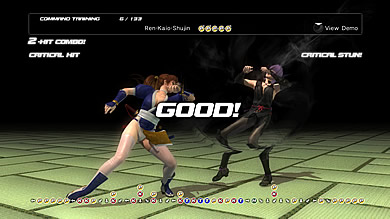

Lean recognizes that overall results are not so much created by large management decisions but by the many, many cycles of very specific work that happen every day on the gemba while managers discuss strategy. This is where the miracle (and often mystery) of lean lies: very, very detailed actions:
Photo dojo stage hand code#
The first key point about dojo is that the actions practiced are incredibly detailed, such as holding bolts in your hand, turning a screw or reading the correct code out of a board with various series of numbers (a dojo exercise I saw at the Takaoka plant). In the Taipei plant there was a safety dojo room to visualize the consequences of poor work habits, and a work dojo. In the lean context, dojo is where basic motion skills are practiced before newbies can hold their place on the line, and sometimes regularly as people are intent to practice their art – just try holding three or four bolts in your hand and you’ll see it’s not as easy as it sounds. “Dojo” is a Japanese word to describe a room or a hall in which martial arts are practiced – from “do”, the way or the pursuit, and “jo”, a place.

I realize this might sound bizarre, but it holds the secret to the true lean spirit.
Photo dojo stage hand how to#
Sensei Joe Lee (now also sensei to the Lean Enterprise China institute) took us to the dojo where we practiced turning marbles around – and how to improve from 14 seconds to 10. Is it important?Ī few weeks ago, I had the good fortune of visiting Toyota’s Taipei Kuozui plant. This system helped him be more aware of where his mind was wandering and start recognizing that he was wasting time.What is a “dojo”? I hear about it but don’t find it referenced in the lean tools. He didn’t want to waste time and he wasn’t being defiant, he just couldn’t snap out of it without a little support. This is also a way to use the green & red system without actually using it, because although he felt as if he was “losing greens”, he really just wasn’t earning them because this was a behavior I was trying to help him manage himself and teaching him to shape. Over time, I decreased the number of greens to 3, then 2, then 1 in order to decrease the number of adult prompts he was receiving to stay on task. It did not take him long to be trained not to waste time. For each time a teacher or aide had to tell him to get started, he lost a green.

Each time he got to a new center he had the opportunity to earn 5 greens. I created a card that had 5 green dots on a strip of velcro. He would fiddle with his glue stick cap…anything. He would take out all of his crayons and line them up on the table in alphabetical order. – Get Started Card: I had a student this year who liked to waste time at the beginning of all of his centers.

You have to know your kids and don’t be afraid to try a few things to figure out what works. Later in this post you’ll read about the million ways I have had to tweak my system to make it work for everyone. Class Dojo is ideal in a special education classroom because it incorporates the green and red reinforcement system which is a research based behavior intervention THAT WORKS!īefore diving in to my behavior management system, one thing I’ll say is that this is what works for me. In the past I have used a variety of classroom management techniques and nothing has ever been as motivating to my kids as Class Dojo. They can be consistent with or without me in the room and consistency goes a looong way with my kiddos! My aides go to specials and lunch with my students so even when I am not with my class, my aides are able to provide the direct reinforcement. We are all able to provide positive and negative reinforcement to our students. First of all, I have to say one of my favorite parts about Class Dojo is the iPhone app because my aides can have it on their phone and log in.


 0 kommentar(er)
0 kommentar(er)
